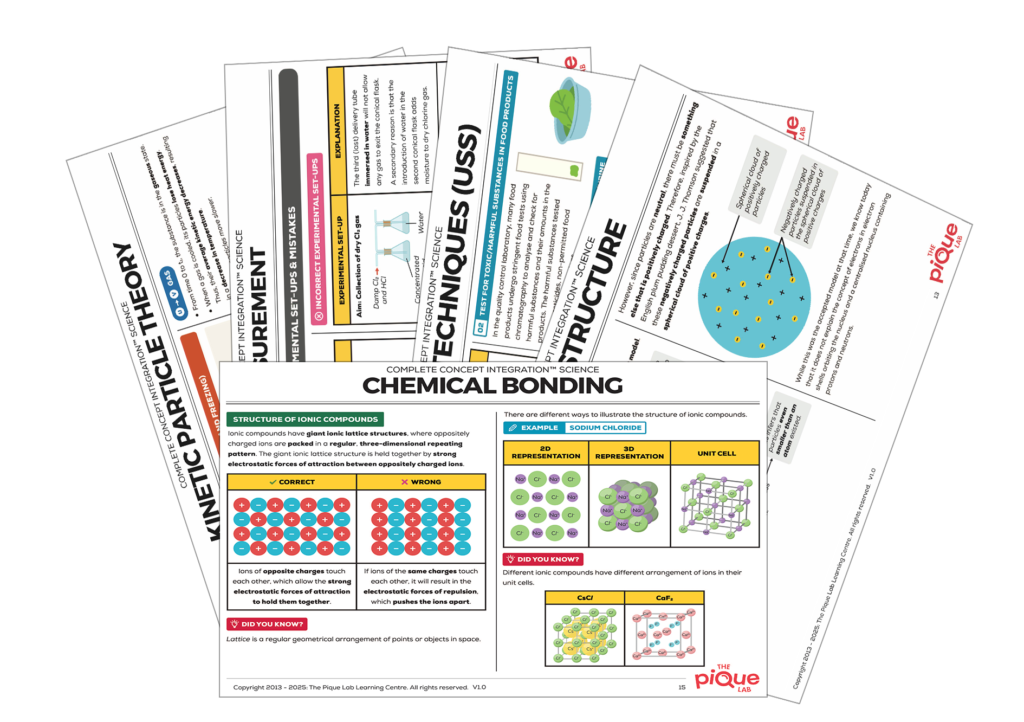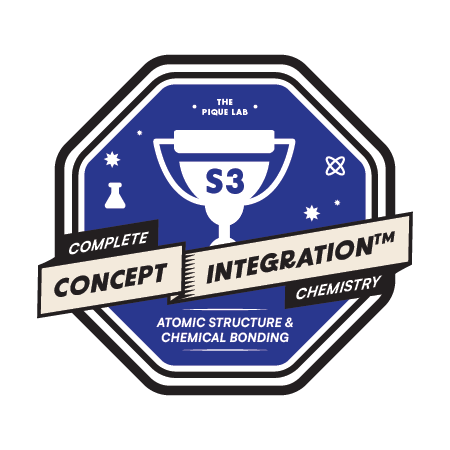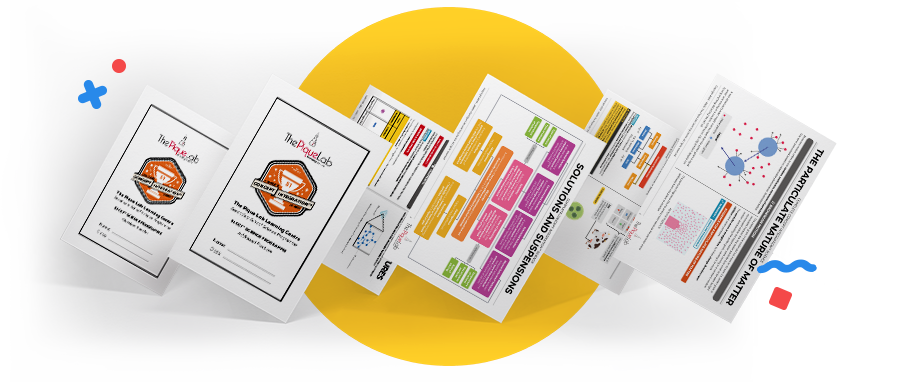
S$547
S3 Content Mastery Course
Become Great At Tackling Chemistry Questions
Discover the proven examination strategies & answering techniques used by over 16,938 students to score As in Chemistry! (AND how your child can do it too… with the right guidance!)
What Your Child Will Learn
During this 3-day content-packed S3 CCI™ Chemistry Course (Atomic Structure & Chemical Bonding), we’ll work closely with your child to improve on his/her mastery of the subject matter:
🧱 Understand Key Chemistry Concepts In The Upper Secondary School Syllabus
We’ll help to break down complex Chemistry concepts using coloured illustrations, comparison charts and worked examples. Next, we’ll help your child relate these concepts with different scenarios so that he/she is better able to understand how these concepts work.
In order to help him/her retain information better, we will also introduce memory retention techniques, such as acronyms and abbreviations. As your child is expected to digest more content in upper secondary school, it will benefit him/her greatly to be able to recall key information easily.
We will also teach your child how to interpret graphs effectively and solve questions using Math.
🎯 Gain Exposure To Various Question Trends & Question Types
Our S3 CCI™ Chemistry Course (Atomic Structure & Chemical Bonding) is all about understanding various examination question trends and question types & how to apply our tested and proven answering techniques to tackle these questions.
Knowing how questions may possibly be tested during examinations helps your child understand what to study and how to study. This also means that your child will be better equipped to tackle similar questions during his/her examinations and hence will be able to process these questions a lot faster than his/her peers.
If your child diligently reviews and applies what we’ve taught, he/she will definitely make progress in their abilities to tackle Chemistry questions.
🚀 Proven ‘Copy and Paste’ Answering Structures, Keywords & Key Phrases
Your child will NOT leave this workshop empty-handed.
Not only will our Secondary Science Specialists take your child through the step-by-step process of tackling Chemistry questions, we’ll also provide your child with beautifully-illustrated notes and worksheets that are designed to help students learn Chemistry easier, better and faster.
These valuable resources will help to shorten the learning curve tremendously. You and your child can expect to save lots of valuable time and frustration trying to figure out what examination setters are looking out for.
Here’s a sample what your child will receive…

💣 Avoid ‘Concept Traps’ That Cause Most Students To Lose Marks Unnecessarily
It is important to have an understanding of the common conceptual pitfalls so that your child can learn to avoid them. We also included little ‘warning notes’ to remind students of potential misconceptions in their syllabus.
Do not underestimate these tips as they will help your child improve the odds of scoring an A for his/her Chemistry examination!

S3 CCI™ Chemistry Course (Atomic Structure & Chemical Bonding)
- Level Eligibility: Secondary 3
(O-Level (Express)/ N(A)/ IP/ IB/ IGCSE) - Sessions: 3
- Total Duration: 9 hours (3 x 3hrs)
- Tuition Fee: S$547
- Learning Arrangement:
- Digital Classes
- Onsite Classes* (subject to changes to National Safe Management Measures)
Topic Coverage
- Session 1: Kinetic Particle Theory, Measurement & Separation Techniques (Part 1)
- Session 2: Separation Techniques (Part 2) & Atomic Structure
- Session 3: Chemical Bonding
About Your Child’s Instructors
Your child will be taught by one of these instructors from our Secondary Science Specialist team.

Here’s What Your Child Will Receive
When your child enrolls today, he/she can look forward to get access to:
- 5 Core Topics Delivered Across 9 Hours of Lesson Time
- 169 Pages of Beautifully-Illustrated Chemistry Notes
- 158 Questions Adapted From Past Year Examination Papers
- 43 Additional Practice Questions
Course Details
Session 1
⚛️ Topic: Kinetic Particle Theory
- Describe the solid, liquid and gaseous states of matter and explain their interconversion in terms of the energy changes involved.
- Describe and explain evidence for the movement of particles in liquids and gases.
- Explain every day effects of diffusion in terms of particles, e.g. the spread of perfumes and cooking aromas; tea and coffee grains in water.
- State qualitatively the effect of molecular mass on the rate of diffusion and explain the dependence of rate of diffusion on temperature.
📏 Topic: Measurement
- Name appropriate apparatus for the measurement of time, temperature, mass and volume, including burettes, pipettes, measuring cylinders and gas syringes.
- Suggest suitable apparatus, given relevant information, for a variety of simple experiments, including drying and collection of gases and measurement of rates of reaction.
🧲 Topic: Separation Techniques (Part 1)
- Suggest suitable apparatus, given relevant information, for a variety of simple experiments, including drying and collection of gases and measurement of rates of reaction.
- Describe methods of separation and purification for the components of mixtures, to include:
(i) use of a suitable solvent, filtration and crystallisation or evaporation
(ii) sublimation
(iii) distillation and fractional distillation
(iv) use of a separating funnel
(v) paper chromatography
Session 2
🧲 Topic: Separation Techniques (Part 2)
- Suggest suitable separation and purification methods, given information about the substances involved in the following types of mixtures:
(i) solid-solid
(ii) solid-liquid
(iii) liquid-liquid (miscible and immiscible) - Interpret paper chromatograms including comparison with ‘known’ samples and the use of Rf values.
- Explain the need to use locating agents in the chromatography of colourless compounds.
- Deduce from given melting point and boiling point data the identities of substances and their purity.
- Explain the importance of measuring the purity in substances used in everyday life, e.g. foodstuffs and drugs.
🔬 Topic: Atomic Structure
- State the relative charges and approximate relative masses of a proton, a neutron and an electron.
- Describe, with the aid of diagrams, the structure of an atom as consisting of protons and neutrons (nucleons) in the nucleus and electrons arranged in shells (energy levels).
- Define proton (atomic) number and nucleon (mass) number.
- Interpret and use nuclide notations such as
 .
. - Define the term isotopes.
- Deduce the numbers of protons, neutrons and electrons in atoms and ions given proton and nucleon numbers.
Session 3
🔗 Topic: Chemical Bonding
- Describe the formation of ions by electron loss/gain and that these ions usually have the electronic configuration of a noble gas.
- Describe, including the use of ‘dot-and-cross’ diagrams, the formation of ionic bonds between metals and non-metals,
e.g. NaCl ; MgCl2. - State that ionic materials contain a giant lattice in which the ions are held by electrostatic attraction, e.g. NaCl.
- Relate the physical properties (including electrical property) of ionic compounds to their lattice structure.
- Describe the formation of a covalent bond by the sharing of a pair of electrons and that the atoms in the molecules usually have the electronic configuration of a noble gas.
- Describe, using ‘dot-and-cross’ diagrams, the formation of covalent bonds between non-metallic elements, e.g. H2; O2; H2O; CH4; CO2.
- Deduce the arrangement of electrons in other covalent molecules.
- Relate the physical properties (including electrical property) of covalent substances to their structure and bonding.
- Describe metals as a lattice of positive ions in a ‘sea of electrons’.
- Describe the general physical properties of metals as solids having high melting and boiling points, malleable, good conductors of heat and electricity in terms of their structure.
- Describe an alloy as a mixture of a metal with another element, e.g. brass; stainless steel.
- Identify representations of metals and alloys from diagrams of structures.
- Explain why alloys have different physical properties to their constituent elements.
- Compare the structures of the following substances in order to deduce their properties:
(i) simple molecular substances, e.g. methane, iodine
(ii) macromolecules, e.g. poly(ethene)
(iii) giant covalent substances, e.g. sand (silicon dioxide), diamond, graphite - Compare the bonding and structures of diamond and graphite in order to deduce their properties such as electrical conductivity, lubricating or cutting action.
- Deduce the physical and chemical properties of substances from their structures and bonding and vice versa.
Who Should Attend This Course?

Any student who wants to score A1 for Upper Secondary Science, but is reluctant to revise using the traditional DRILLING method.
Your child is the kind of student who wants to outperform his/ her peers & study the SMART way, like many other high performing students.

Students who are having tuition that simply do not work for them.
You probably have invested thousands of dollars & months of time, but it’s just not working out.
Your child isn’t exactly progressing much & you’re looking for a change in environment.

Existing high performing students who want to strengthen their thought process & refine their answers to perfection!
Your child has been consistently scoring B3/A2, but struggle to get a breakthrough to the A1, no matter how hard he/she has tried.
Don’t Just Take Our Word For It.
Hear What Parents & Students Have To Say About Their Experience With Us.
Very Useful & Helpful!
“The S1 CCI was very helpful. Before attending the session, my daughter had difficulty in understanding certain Science concepts.
After attending the session, she has a better understanding of the topics and is now able to solve the questions using efficient methods. She is also able to use the notes and extra practices provided for revision.
Overall, the course was very useful and helpful and I highly recommend the course to other parents.
Understand The Chapters Easily!
“I want to thank Mr Ryan for teaching me carefully and efficiently. He makes me understand the chapters easily.
Lessons are always engaging!
“Hi Mr Ryan, your lessons are always engaging, allowing me to be more interested in Science than before. I always look forward to classes and improve my understanding of the Science content. At the start of the year, I did not like doing Science questions as they looked hard. However, towards the end of the year, I found Science open ended questions to be interesting and is more willing to do more papers.
If You’re Still On The Fence, Hear Us Out.
Over the past seven years, we’ve seen more than 3,451 students attend the CCI Science Course, achieving phenomenal improvements in their understanding of the subject matter & more importantly, their results.
We’ve been getting these raving testimonials from happy parents weekly after their kids have benefitted immensely from our help. Click here to see what other parents have been saying about our CCI Science Courses.
In case you’re wondering…
This is NOT one of those enrichment programs where students gain loads of theories and do nothing with them afterwards!
As your child will get to apply whatever they’ve learned directly on school examination questions during the course … by the time your child has completed the course, he/ she will be trained on how to tackle his/ her school homework & school examination papers accurately & efficiently.
Not a month later… or even a week later, but immediately!
During the S3 CCI™ Chemistry (Atomic Structure & Chemical Bonding) course, we’ll be revealing some massively potent studying strategies used by our top-performing students. These strategies have helped them save hours studying every day and yet allow them to score A1s during their school examinations time & time again!
So… if you are looking for:
1) A highly robust methodology to sharpen your child’s Chemistry answering techniques, especially in their open-ended section (… such that he/she no longer loses marks unnecessarily due to missing links, key words or key phrases)
2) An engaging teacher with a strong proven track record (… trust me: teachers make or break the learning experience for students. Set them up with the right teacher & they’ll enjoy the learning process for life)
3) A comprehensive set of visually-appealing revision materials that high-performing students use to excel in their examinations (… you’d want your child to get his/her hands on these materials & start revising now. The best part: Your child doesn’t have to spend countless of hours trying to study, because we’ve distilled the most important parts to take note!)
… then this course may just be perfect for your child.

Now, let’s be real. Is this going to be easy?
There is ALWAYS going to be a bit of discomfort, uncertainty and plenty of hard work when your child is trying to learn and apply our answering structures to tackle examination questions. That is normal & many of our students go through the same process all the time.
Once your child pushes past that discomfort, that’s when you will notice real growth in his/her learning. It will not be a walk in the park, but we have plenty of materials & close guidance to help your child improve his/her answering techniques!
We’ll see your child at the workshop!
Frequently Asked Questions
How is the S3 CCI™ Chemistry Course (Atomic Structure & Chemical Bonding) different from other tuition programs out there?
It’s NOT a trial class nor a typical program where you expect 20-30 students crammed in a class, in a bid to do some last-minute rescue work. The CCI™ Chemistry course is designed to solidify your child’s fundamentals in Chemistry, so he/ she can tackle open-ended Chemistry questions with ease & precision.
Here’s how it works: Throughout our teaching careers, we have perfected a number of strategies and tactics that are proven to work for our students. More importantly, these strategies are carefully documented in our course material, so these best practices could be taught effectively to new students. We will not hold any back “secret tactics” (unlike traditional kungfu masters) & these strategies would be EXACTLY THE SAME as the ones taught to our high performers.
Please note that our S3 Complete Concept Integration™ Chemistry Course (Atomic Structure & Chemical Bonding) is not for everyone. They work best for students who have the will & determination to do well, but are lacking the right strategies to get to A1. Our strategies are all meat and no fluff. If you want lengthy theories, please read the textbook instead. Our S3 CCI™ Chemistry course is all about taking action and getting results as quickly and easily as possible!
Will there be breaks in between classes?
Yes, we typically offer a 5-10 minutes break for every 1-hour of learning.
What topics are covered?
- Session 1: Kinetic Particle Theory, Measurement & Separation Techniques (Part 1)
- Session 2: Separation Techniques (Part 2) & Atomic Structure
- Session 3: Chemical Bonding
Will there be homework provided during the workshop?
There’ll not be any homework given during the workshop. The S3 CCI™ Chemistry Course is a highly intensive workshop. Both concepts and answering techniques will be taught in class and we’ll teach your child how to apply these techniques on secondary school examination questions.
We will give your child a question booklet containing a curated list of open-ended questions adapted from secondary school examination papers. These questions have been adapted from different schools & sorted based on their topics. A portion of the questions will be attempted & reviewed in class. The remaining questions can be brought home for their own practice. We’ll also send you an answer booklet for the questions in the S3 CCI™ Chemistry Course.
My child is in the IP/ IB/ IGCSE academic track. Is your programme suitable?
Our S3 CCI™ Chemistry Course (Atomic Structure & Chemical Bonding) is designed based on the O-Level (Express) track.
Based on research, it appears that there’re only minor differences in terms of content coverage between the O-Level (Express) track and the IP/IB/IGCSE track at a lower secondary level.
As such, it will be suitable for your child to participate if he/she is interested.
Who is the instructor for the class?
Our classes are conducted by our team of highly-popular Secondary Science Specialists.
Our Science Specialists have collectively more than ten years of teaching experience under their belts. During which, they have experimented with plenty of studying strategies, keywords & template answers. More importantly, they know what works for the student and what doesn’t.
Using the proven techniques from our Complete Concept Integration™ program, they have helped more than 80% of their students clinch As during their Science examination. Seasoned by experience, they’re known among parents for building rapport with their students & helping them achieve tremendous academic results in the shortest period of time.
What is the maximum class size?
Our S3 CCI™ Chemistry Course is typically fully booked. You can expect the class to have 14 to 16 students.
What kind of materials would my child be getting?
Your child would be receiving a comprehensive set of notes, covering a selected number of Secondary 3 Chemistry topics (see above) that we’ll be discussing during the S3 CCI™ Chemistry Course (Atomic Structure & Chemical Bonding). On top of that, he/she will be receiving a question booklet containing a curated list of open-ended questions adapted from secondary school examination papers.
These questions have been carefully adapted different schools & sorted based on their topics. As such, your child would have the opportunity to apply the thought processes and answering techniques learnt on these questions immediately.
S3 Complete Concept Integration™ Chemistry Course Details
Suitable For Students In O-Level (Express)/ Normal Academic/ IP*/ IB*/ IGCSE* Track (*See FAQ)

Hello There!
There are NO available S3 Complete Concept Integration™ Chemistry (Atomic Structure & Chemical Bonding) Course at this point in time.
If you’d like to be given the heads up when our enrollments open, please fill in the Interest Check form below.
Thank you!
Course Registration Form
Please fill in the following form accurately.
Note: You’ll be redirected to a confirmation page after the above registration has been successfully processed.

Have Any Questions?
Don’t worry, let us help you. Click the button below to schedule a free call-back.
